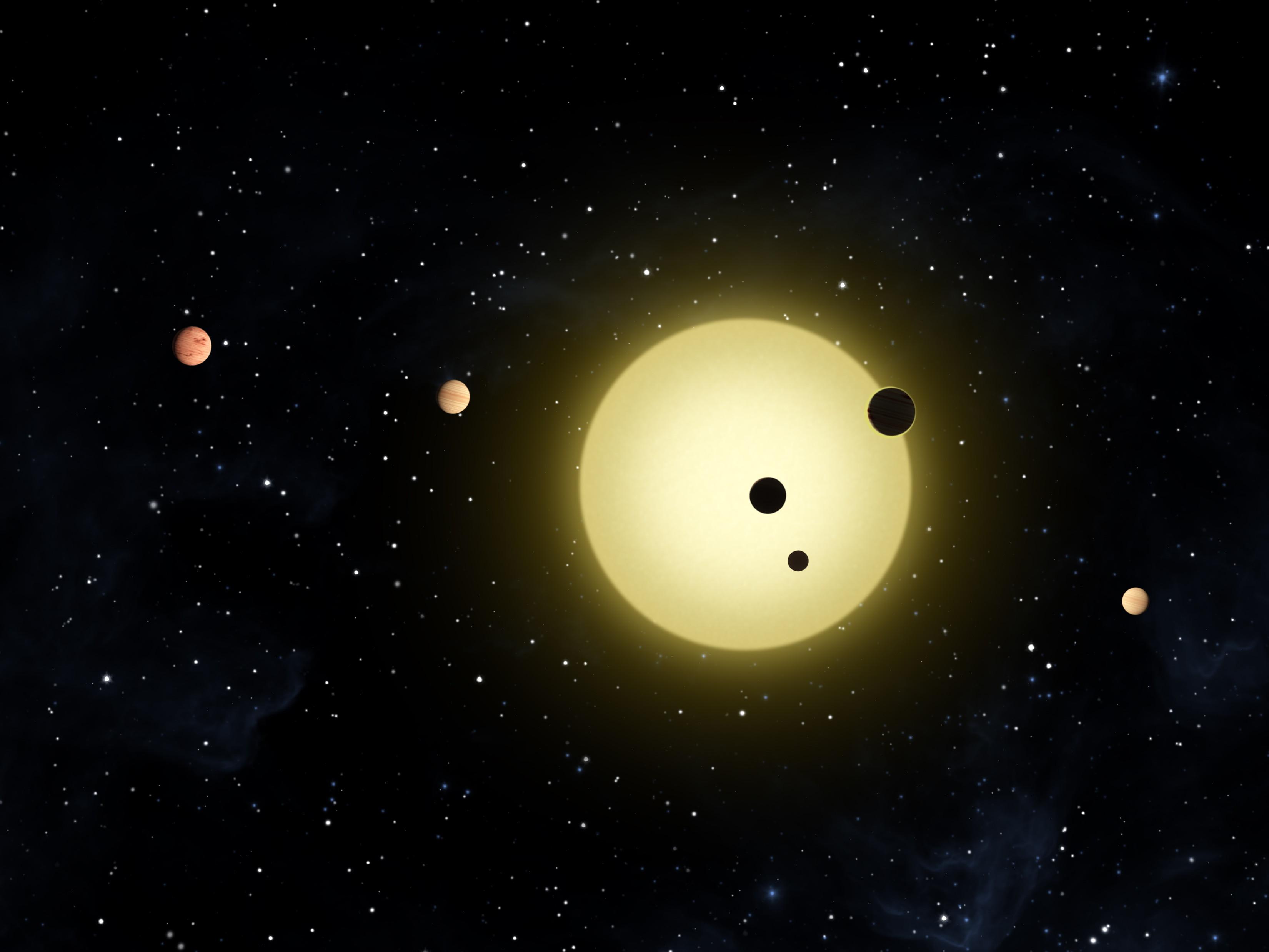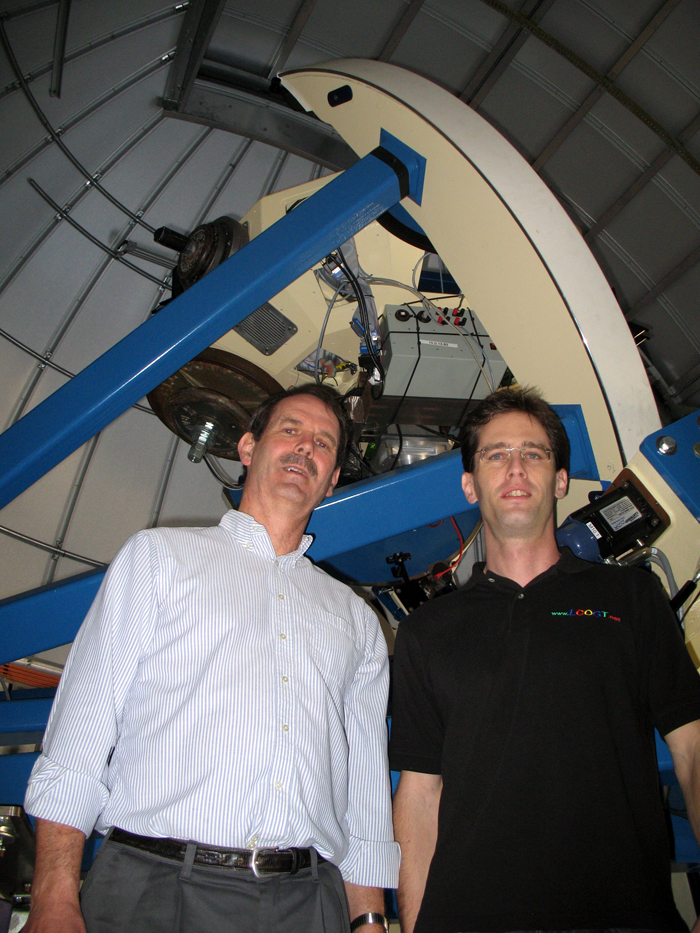The Israeli astronomer Avi Shaforer from the University of California at Santa Barbara was also involved in the discovery


NASA's Kepler Space Telescope has discovered candidates for an Earth-sized planet, the first of its kind, and more importantly the first of its kind to be discovered in the habitable zone, a region where liquid water can exist on the planet's surface.
Five of the candidates for planets similar in size to Earth are in the habitable zone of a star smaller and colder than the Sun. Kepler also discovered six already confirmed planets orbiting the Sun-like star Kepler-11. This is the largest group of planets orbiting a star discovered by the eclipse method.
Kepler observes the signature of the planets by measuring the tiny drop in star brightness caused by the planet passing in front of them in our field of view. This method is known as the transition method. Since the transit of planets in the habitable zone of a sun like ours takes about a year, and three transits are required to confirm the fact that it is a planet, confirmation of the discovery will require at least three years.
The Kepler mission discovered 1235 bodies that could be planets, including 54 planets that are just the right distance from their star so that they are neither too hot nor too cold and may contain liquid water. IT is calling us and maybe even calling us right now...
Nature magazine reports that hundreds of celestial spots have been identified, which they estimate may be planets, and even some of them could definitely be candidates for Earth number two - a small rocky planet, with an orbit of several hundred days, on which water can exist and, of course, life.
Last month, according to Nature, NASA announced the discovery of the smallest planet that exists outside our solar system. Its diameter is 1.4 times that of Earth and its mass is 4.6 times that of our planet. Although the planet orbits too close to its star to support life, the news was reported as a major breakthrough in the search for a new Earth, especially because it is the first rocky minor planet outside the solar system.
The planet was discovered by NASA's Kepler spacecraft. The Kepler spacecraft was designed as a space telescope with a diameter of 0.95 meters in order to discover exoplanets (planets outside the solar system). It works by monitoring changes in the light from the stars. Unlike most ground-based telescopes, the Kepler mission is designed to focus on the same field of view for 3 to 4 years. This field contains about 150,000 stars in the Lyra and Cygnus systems. These systems were chosen because they have so many stars that they are similar to our sun. Because Kepler focuses on the same point he is able to repeat observations, make three or four repeated observations of transits of minor planets in one-year orbits, the orbit of the Earth around the Sun. And so it is able to capture planets similar to ours.
Two astronomers from the Department of Physics at the University of California, Santa Barbara, Tim Brown and Avi Shaffer, are involved in the mission. Both are also scientists at the university's Coombs Global Observatory, which is run by Brown.
Brown is a co-researcher at Kepler and he had a significant role in the project from the beginning of its planning in the early nineties. Among other things, he signed a catalog of about 156 sun-like stars among the millions of stars in Kepler's field of view.

Statistical analysis of samples of many planet candidates show us that planets come in groups, this means that they reside side by side with other planets and are not alone," Shaporr said.
Another interesting result based on the large sample of candidates discovered by Kepler is that when you consider the geometric probability of the planet Albor from its sun, close to 20% of all stars that have planets, this means that a significant fraction of the stars in the sky are surrounded by alien worlds ” says Brown.
Neitzer says that every month the astronomers download from the Kepler spacecraft to the computers at NASA a stream of light intensity data captured by Kepler. There is a decrease in the brightness of the stars as the planets pass in front of the stars or pass by them. Astronomers need three to four such transits to be sure they have found a planet. These data are converted into graphs that the computer produces. The graphs show the intensity of the light from the star on one axis and on the other axis the change in time of this intensity. Draw additional graphs and get spots that correspond to the planets. Then they filter out the noise of the instruments in the Kepler spacecraft. After all the tedious process they conclude that some of the data are planets. To know that it is not noise but a real planet, the Spitzer space telescope is used, which is sensitive to infrared radiation. It is ideal for noise cancellation. Kepler's findings are also used to direct telescopes here on Earth.
Based on Kepler's data, the researchers found a system in which there is a pair of planets, which are about the size of Jupiter, and have a mass that is of the order of that of Saturn, and they orbit the same star in orbits of several days. Another giant planet was discovered in the same system. Then they discovered another system, where six planets orbit a star and have cycles of between a few days and almost 120 days. Their masses range from twice that of the Earth to 300 times the mass of the Earth. And now they discovered another dense planet, which revolves around a star just like our sun in a short 84-day orbit. The planet is very close to its sun and its mass is 4.6 times that of Earth. And there is no doubt that in this situation it is rocky. But because it is close to its sun at least one side of it must be melting all the time.
All exoplanets confirmed to exist so far orbit much closer to their stars than Earth does. They are too close to the star to develop the existence of flowing water, which is what defines a "habitable zone". However, as the data is collected from the Kepler spacecraft and carefully examined, it is estimated that they will produce reports of smaller and smaller planets, until we get an example that is exactly the size of Earth.
Eventually we may find an Earth-like planet orbiting a star similar to our Sun. If this were to be the case, should the planet be the size of Earth? And should we focus on a planet on which liquid water flows? Perhaps in general life in other remote corners of the universe is more diverse and strange than we expected. In this situation, we might think about life on a completely dry world and then discover the first planet capable of supporting life that we never expected to discover.

15 תגובות
Yoel
that's new. Rabbis who know astronomy. If they claimed the opposite, where would they use the Babylonian Talmud and where would they use the Jerusalem Talmud, what would they write about it in the Tractate of Yavem, and what would the rules of Nida be in those stars?
Yoel, are these the same guys who say that God is 5000 or so years old?... Just to make it clear which great men of Israel we are talking about.
There is no life outside the earth according to Judaism Rabbis and elders of Israel explicitly say that there are no geographical worlds like the earth in which humans, animals and plants live.
David (3),
At this stage it is about discovering planets that may support the conditions that allow life, as we know it.
From here until you connect with intelligent extraterrestrials, the distance is... cosmic. There is nothing to talk about.
my first father,
From your words it appears that the "creator" is not a governor everywhere but is limited to the borders of the earth or at most the solar system.
This is of course not true since it is known that the domain of God's control is much larger and extends over many light years and this can be learned from the fact that his distance from the earth is 9.5 light years and his control is still evident over everything.
http://www.independent.co.uk/arts-entertainment/books/reviews/big-bang-by-simon-singh-755012.html
Is anyone updating the drake equation with the new data? I think it is even worth updating the variables themselves according to the latest scientific discoveries.
What is the estimated lifespan of the Kepler space telescope? After 4 years, will he continue watching in the same area, or will he move to another area?
Is there a site that shows the stars found in a more graphical way, not just as a collection of numerical data?
What will be the next steps after we have found Earth-like stars? I guess we will try to check if they have an atmosphere, and if so, do spectrometry for the atmosphere to analyze the composition of the atmosphere. Does finding oxygen and methane necessarily show the existence of life?
There are so many questions here that you could write a whole article on the subject....
Why do you always have to mix religion with science? And if you're already mixing, then at least interesting comments that can trigger a new point of thought in our minds...
What do you know father?
Maybe your creator also visited there and created a life there too? In his image and likeness? What prevents him from doing so? Nothing - he is all-powerful, he created all the stars and planets.
(Clarification - Spaghetti and I have nothing to do with each other, I'm just being silly 🙂 )
Avi:
They write about God in ultra-Orthodox rooms.
The Flying Spaghetti Monster has its own website.
Here they deal with science.
They may find different "elements of life" (such as water, environmental conditions, etc.) but not life.
Because for life there must be a creator. One who will connect those "life components" to life.
And what is their distance from the earth?
Will it be possible to communicate with life there?
in what language?
The five Earth-sized planets in the habitable zone do not orbit a single star but five different stars. The reason most potential planets in the habitable zone orbit relatively cold suns is because in order for an eclipse event to be considered a potential planet it has to occur twice. Since cold stars have a habitable zone closer to the sun, in the first phase of the mission mainly such stars will be discovered. I assume that in the next updates there will also be planets in the habitable zone of hot suns.
There is also an article in the Register:
http://www.theregister.co.uk/2011/02/03/kepler_11/